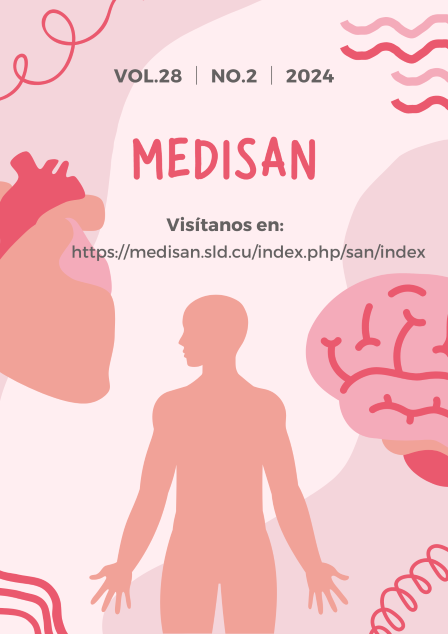Main clinical and epidemiological characteristics of patients with peripartum cardiomyopathy
Keywords:
peripartum period, cardiomyopathy, heart failure, cardiopathy, pregnancy.Abstract
Introduction: Cardiovascular diseases represent an important cause of morbidity and mortality during pregnancy, cardiomyopathy is notable as a syndrome of heart failure.
Objective: To characterize patients with peripartum cardiomyopathy according to clinical and epidemiological variables of interest for the investigation.
Methods: A descriptive and cross-sectional study of 18 patients with diagnosis of peripartum cardiomyopathy was carried out. They were assisted at Dr. Juan Bruno Zayas Alfonso Teaching General Hospital in Santiago de Cuba from October, 2015 to December, 2022.
Results: In the series there was a prevalence of patients over 35 years (32.6 average age), besides African descendant (50.0 %), chronic hypertension (44.4 %) and multiparity (8.9 %) as risk factors and the left ventricle failure as clinical manifestation. The ejection fraction of this ventricle was regularly diminished and the pharmacological treatment response was satisfactory in all the sample.
Conclusions: Peripartum cardiomyopathy is of low incidence in this center; however, due to its seriousness, the early diagnosis and the specialized staff intervention are necessary to avoid complications.
Downloads
References
2. Siu SC, Silversides CK. Pregnancy and heart disease. En: Libby P, Bonow RO, Mann DL, Tomaselli GF, Bhatt DL, Solomon SD. En: Braunwald’s Heart Disease. 12th ed. Philadelphia: Elsevier; 2022. p. 1723-42.
3. Slomski A. Why do hundreds of us women die annually in childbirth? JAMA. 2019 [citado 22/04/2023];321(13):1239-41. Disponible en: https://jamanetwork.com/journals/jama/fullarticle/2728576
4. Pérez Torga JE, Román Rubio PA, García Sánchez I, Sánchez Ramírez NM, Castillo Arocha I, Peña Boffil V. Cardiomiopatía periparto. Rev. cuba. obstet. ginecol. 2016 [citado 22/04/2023];42(2). Disponible en: http://www.scielo.sld.cu/scielo.php?script=sci_arttext&pid=S0138-600X2016000200009
5. Davis MB, Arany Z, McNamara DM. Peripartum cardiomyopathy: JACC state of the art review. J Am Coll Cardiol. 2020 [citado 22/04/2023];75(2):207-21. Disponible en: https://pubmed.ncbi.nlm.nih.gov/31948651/
6.Elkayam U, Goland S, Pieper PG, Silverside CK. High-risk cardiac disease in pregnancy: Part I. J Am Coll Cardiol. 2016 [citado 22/04/2023];68(4):396–410. Disponible en: https://pubmed.ncbi.nlm.nih.gov/27443437/
7. Martínez Hugo S, González A. Miocardiopatía periparto: revisión de la literatura. Rev. Chil. Cardiol. 2022 [citado 22/04/2023];41(2). Disponible en: https://www.scielo.cl/scielo.php?script=sci_arttext&pid=S0718-85602022000200119
8. Windram J, Grewal J, Bottega N, Sermer M, Spears D, Swan L, Siu SC, Silversides C. Canadian Cardiovascular Society: Clinical Practice Update on Cardiovascular Management of the Pregnant Patient. Can J Cardiol. 2021 [citado 22/04/2023]; 37(12). Disponible en: https://onlinecjc.ca/article/S0828-282X(21)00356-1/fulltext
9. D’Souza RD, Silversides CK, Tomlinson GA, Siu SC. Assessing cardiac risk in pregnant women with heart disease: How Risk Scores Are Created and Their Role in Clinical Practice. Can J Cardiol. 2020 [citado 22/04/2023];36(7):1011-21. Disponible en: https://onlinecjc.ca/article/S0828-282X(20)30184-7/abstract
10. República de Cuba. Ministerio de Salud Pública. Dirección Nacional de Estadística. Anuario Estadístico de Salud 2022. La Habana: MINSAP; 2023 [citado 22/04/2023]. Disponible en: https://files.sld.cu/dne/files/2023/10/Anuario-Estadistico-de-Salud-2022-Ed-20231.pdf
11. Elkayam U, Goland S, Pieper PG, Silversides CK. High-Risk Cardiac Disease in Pregnancy: Part II. J Am Coll Cardiol. 2016 [citado 22/04/2023]; 68(5):502-16. Disponible en: https://pubmed.ncbi.nlm.nih.gov/27443948/
12. Armstrong WF, Ryan Th. Feigenbaum’s echocardiography. 8 ed. Philadelphia: LWW; 2018 [citado 22/04/2023]. Disponible en: https://www.amazon.com/Feigenbaums-Echocardiography-William-F-Armstrong/dp/1451194277
13. Gutiérrez Abarca L. Miocardiopatía periparto en 2021: ¿con qué contamos para su tratamiento? Rev Colombiana Cardiol. 2021 [citado 22/04/2023];28(6):523-9. Disponible en: https://www.rccardiologia.com/frame_esp.php?id=106
14. Saint Croix G, Ibrahim M, Chaparro S. Use of bromocriptine in the management of peripartum cardiomyopathy. Cardiovasc Investig. 2018 [citado 22/04/2023];2(1). Disponible en: https://www.primescholars.com/articles/use-of-bromocriptine-in-the-management-of-peripartum-cardiomyopathy-a-systematic-review-and-metaanalysis.pdf
15. McDonagh TA, Metra M, Adamo M, Gardner RS, Baumbach A, Böhm M, et al. Guía ESC 2021 sobre el diagnóstico y tratamiento de la insuficiencia cardiaca aguda y crónica. Rev Esp Cardiol. [citado 22/04/2023];2022;75(6):1-523. Disponible en: https://doi.org/10.1016/j.recesp.2021.11.027
16.Tanaka K, Tanaka H, Kamiya C, Katsuragi S, Sawada M, Tsuritani M, et al. Beta-blockers and fetal growth restriction in pregnant women with cardiovascular disease. Circ J. 2016 [citado 22/04/2023];80(10):2221-6. Disponible en: https://doi.org/10.1253/circj.CJ-15-0617
17.Shekhar S, Gupta N, Kirubakaran R, Pareek P. Oral nifedipine versus intravenous labetalol for severe hypertension during pregnancy. BJOG. 2016 [citado 22/04/2023];123(1):40-7. Disponible en: https://obgyn.onlinelibrary.wiley.com/doi/10.1111/1471-0528.13463
18. Pfaller B, Sathananthan G, Grewal J, Mason J, D'Souza R, Spears D, et al. Preventing complications in pregnant women with cardiac disease. J Am Coll Cardiol. 2020 [citado 22/04/2023];75(12). Disponible en: https://doi.org/10.1016/j.jacc.2020.01.039
19. Lane Cordova AD, Khan SS, Grobman WA, Greenland P, Shah SJ. Long-term cardiovascular risks associated with adverse pregnancy outcomes. J Am Coll Cardiol. 2019 [citdo 22/04/2023];73(16). Disponible en: https://doi.org/10.1016/j.jacc.2018.12.092
Published
How to Cite
Issue
Section
License
All the articles can be downloaded or read for free. The journal does not charge any amount of money to the authors for the reception, edition or the publication of the articles, making the whole process completely free. Medisan has no embargo period and it is published under the license of Creative Commons, International Non Commercial Recognition 4.0, which authorizes the copy, reproduction and the total or partial distribution of the articles in any format or platform, with the conditions of citing the source of information and not to be used for profitable purposes.





